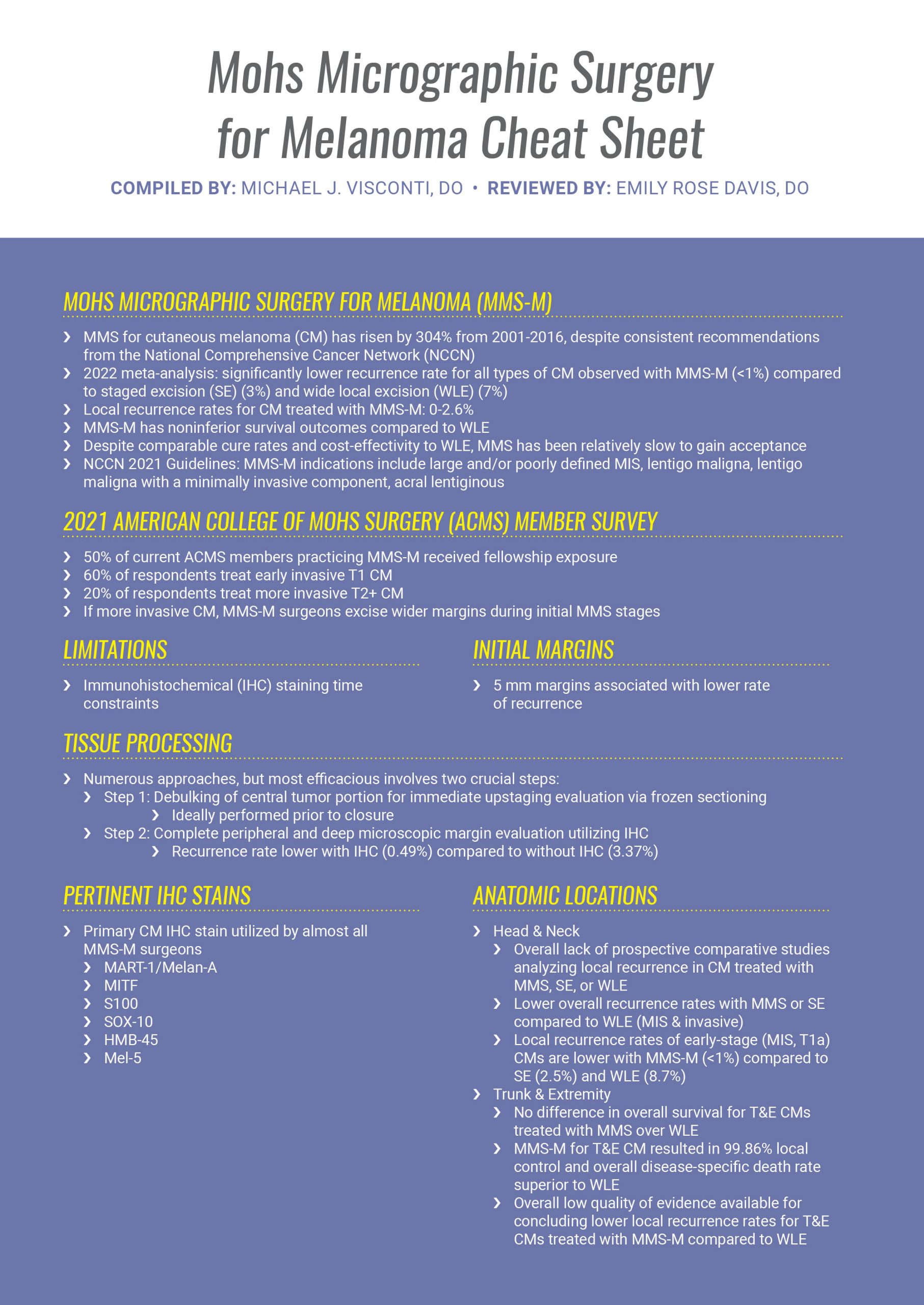Mohs micrographic surgery for melanoma (MMS-M) has sharply risen by 304% in a 15-year interval, despite consistent recommendations from the National Comprehensive Cancer Network (NCCN). The aim of this therapeutic cheat sheet is to provide a high-yield literature review of the most pertinent data related to MMS-M.
Mohs Micrographic Surgery for Melanoma (MMS-M) |
|
| ● MMS for cutaneous melanoma (CM) has risen by 304% from 2001-2016, despite consistent recommendations from the National Comprehensive Cancer Network (NCCN) | |
| ● 2022 meta-analysis: significantly lower recurrence rate for all types of CM observed with MMS-M (<1%) compared to staged excision (SE) (3%) and wide local excision (WLE) (7%)
● Local recurrence rates for CM treated with MMS-M: 0-2.6% ● MMS-M has noninferior survival outcomes compared to WLE |
|
| ● Despite comparable cure rates and cost-effectivity to WLE, MMS has been relatively slow to gain acceptance | |
| ● NCCN 2021 Guidelines: MMS-M indications include large and/or poorly defined MIS, lentigo maligna, lentigo maligna with a minimally invasive component, acral lentiginous | |
2021 American College of Mohs Surgery (ACMS) Member Survey |
|
| ● 50% of current ACMS members practicing MMS-M received fellowship exposure
● 60% of respondents treat early invasive T1 CM ● 20% of respondents treat more invasive T2+ CM ● If more invasive CM, MMS-M surgeons excise wider margins during initial MMS stages |
|
Limitations |
|
| · Immunohistochemical (IHC) staining time constraints | |
Initial Margins |
|
| ● 5 mm margins associated with lower rate of recurrence | |
Tissue Processing |
|
| ● Numerous approaches, but most efficacious involves two crucial steps:
○ Step 1: Debulking of central tumor portion for immediate upstaging evaluation via frozen sectioning ■ Ideally performed prior to closure ○ Step 2: Complete peripheral and deep microscopic margin evaluation utilizing IHC ■ Recurrence rate lower with IHC (0.49%) compared to without IHC (3.37%) |
|
Pertinent IHC Stains |
|
|
● Primary CM IHC stain utilized by almost all MMS-M surgeons ○ MART-1/Melan-A
|
● MITF
● S100 ● SOX-10 ● HMB-45 ● Mel-5 |
Anatomic Locations |
|
| Head & Neck | Trunk & Extremity |
| ● Overall lack of prospective comparative studies analyzing local recurrence in CM treated with MMS, SE, or WLE
● Lower overall recurrence rates with MMS or SE compared to WLE (MIS & invasive) ● Local recurrence rates of early-stage (MIS, T1a) CMs are lower with MMS-M (<1%) compared to SE (2.5%) and WLE (8.7%)
|
● No difference in overall survival for T&E CMs treated with MMS over WLE
● MMS-M for T&E CM resulted in 99.86% local control and overall disease-specific death rate superior to WLE ● Overall low quality of evidence available for concluding lower local recurrence rates for T&E CMs treated with MMS-M compared to WLE |

References
1. Bednar, E. Dimitra, Michael Zon, and Mohannad Abu-Hilal. “Morbidity and Mortality of Melanoma on the Trunk and Extremities Treated With Mohs Surgery Versus Wide Excision: A Systematic Review.” Dermatologic Surgery 48.1 (2022): 1-6.
2. Bittar, Peter G., et al. “Systematic review and meta-analysis of local recurrence rates of head and neck cutaneous melanomas after wide local excision, Mohs micrographic surgery, or staged excision.” Journal of the American Academy of Dermatology 85.3 (2021): 681-692.
3. Burnett, Mark E., David G. Brodland, and John A. Zitelli. “Long-term outcomes of Mohs micrographic surgery for invasive melanoma of the trunk and proximal portion of the extremities.” Journal of the American Academy of Dermatology 84.3 (2021): 661-668.
4. Demer, Addison M., et al. “Association of Mohs micrographic surgery vs wide local excision with overall survival outcomes for patients with melanoma of the trunk and extremities.” JAMA dermatology 157.1 (2021): 84-89.
5. Force, Ad Hoc Task, et al. “AAD/ACMS/ASDSA/ASMS 2012 appropriate use criteria for Mohs micrographic surgery: a report of the American academy of dermatology, american college of mohs surgery, american society for dermatologic surgery association, and the american society for mohs surgery.” Journal of the American Academy of Dermatology. 67.4 (2012): 531-550.
6. Krausz, Aimee E., et al. “Systematic review of technical variations for Mohs micrographic surgery for melanoma.” Dermatologic Surgery 47.12 (2021): 1539-1544.
7. Miller, Christopher J., and Christopher K. Bichakjian. “Mohs Micrographic Surgery for Melanoma—Do Outcomes Vary Among Treatment Facilities?.” JAMA dermatology 157.5 (2021): 513-515.
8. Pride, Renee LD, et al. “Local recurrence of melanoma is higher after wide local excision versus Mohs micrographic surgery or staged excision: a systematic review and meta-analysis.” Dermatologic Surgery 48.2 (2022): 164-170.
9. Sharma, Ajay N., et al. “Mohs surgery for the treatment of lentigo maligna and lentigo maligna melanoma–a systematic review.” Journal of Dermatological Treatment 32.2 (2021): 157-163.
10. Siscos, Spyros M., et al. “Practice habits of Mohs surgeons treating melanoma with Mohs surgery: A cross-sectional survey.” Journal of the American Academy of Dermatology84.3 (2021): 833-835.
11. Theunissen, Chantal CW, et al. “Systematic review of the role of Mohs micrographic surgery in the management of early-stage melanoma of the head and neck.” Dermatologic Surgery47.9 (2021): 1185-1189.
12. Vieira, Carlos, et al. “Recurrence rate for melanoma excised by Mohs micrographic surgery without immunostaining.” Dermatologic Surgery 48.5 (2022): 492-497.
Did you enjoy this Surgical Dermatology Cheat Sheet? You can find more here.

